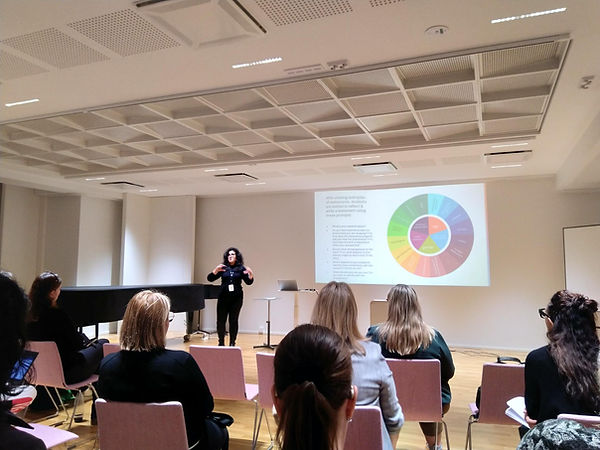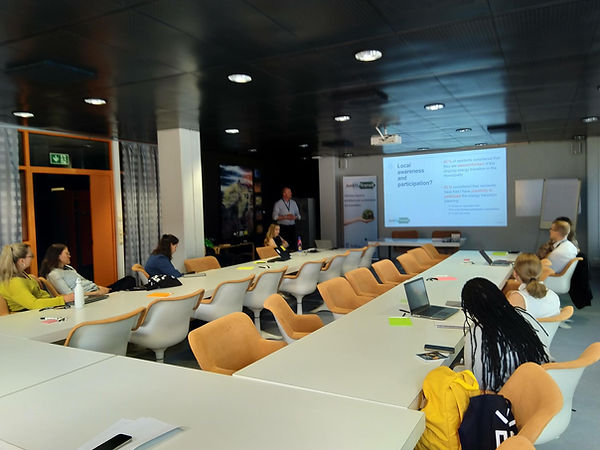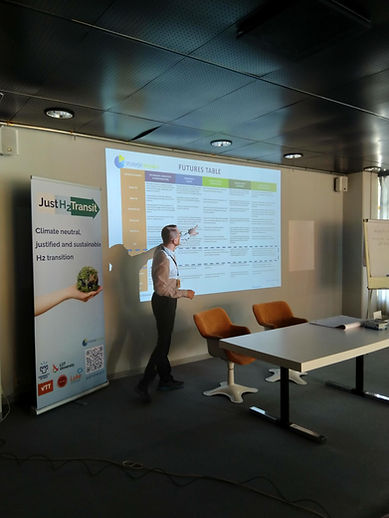The Power of Interdisciplinary Research and Collaboration
August 6, 2025
Henna Longi
The 47th Association for Interdisciplinary Studies (AIS) Conference, themed “Shaping the Future in the Era of Polycrisis,” took place in Oulu, Finland, from June 4–6. This marked only the second time the AIS conference was held in Europe, drawing international participants passionate about multidisciplinary, interdisciplinary, and transdisciplinary research and education.
Researchers from the JustH2Transit project were honored to participate and host a dedicated session titled “Justice in Hydrogen Transition: A Systemic and Practical Perspective.”
Interdisciplinary Approaches in the Era of Polycrisis
The conference theme—Polycrisis—highlighted the urgent need to understand the interconnected challenges of our time. In a world overwhelmed by complexity and information overload, interdisciplinary approaches are more essential than ever.
In her keynote, Bianca Vienni Baptista addressed the persistent gaps in understanding and supporting inter- and transdisciplinary (ITD) practices. She warned of superficial collaborations that mimic ITD without truly embracing its principles, and highlighted the lack of institutional recognition, funding, and policy support for genuine ITD work.
To foster a cultural shift in ITD, she proposed three key actions:
-
Refining theories and methods to better investigate ITD.
-
Mapping and recognizing ITD expertise
-
Contributing to policy, impact assessment, and funding frameworks that support ITD.

Gabriele Bammer moved further the discussion by encouraging researchers to reflect on their roles in addressing complex problems:
-
What is your core skill set and how do you want to expand it?
-
How do you want to contribute?
-
What expertise do others bring?
She introduced the Integration and Implementation Sciences (i2S) approach, supported by a community weblog and repository that shares tools, frameworks, and competencies for tackling societal and environmental challenges.
Anastasia Hacopian echoed this individual focus, emphasizing how our identities—shaped by experience, culture, and academic background—affect how we perceive and study the phenomenon of polycrisis.

For interdisciplinary teams like JustH2Transit consortium, it was affirming to see our collaborative practices reflected in the scientific discourse. As Verena Knerich noted, successful interdisciplinary work requires, e.g.:
-
Understanding each team member’s expertise,
-
A shared vision and language,
-
Clearly defined roles and responsibilities.
Justice in Hydrogen Transition: A Systemic and Practical Perspective
Our session at the conference aimed to share insights from the JustH2Transit project, foster dialogue, and gather feedback for future work.
Nina Wessberg opened with an overview of Finland’s hydrogen strategy and the broader energy transition landscape. Jarkko Saarinen followed with a regional development perspective, exploring alternative visions for Finland in 2040 depending on the trajectory of the energy transition. He presented early findings from the empirical research done in three municipalities, including:
-
50% considered that residents had/have possibility to participate in energy transition planning.
-
Top 5 concerns energy investments create: Environmental impacts, technical/planning issues, landscape changes, community identity shifts, and noise/light effects.
-
From the local politicians and decision-makers, 91% agreed that cross-border collaboration is needed, yet only 15% agreed that municipalities are currently collaborating in energy transition.

Pasi Riikkonen introduced the socio-technical scenarios developed for Finland’s clean hydrogen transition, while Nina Wessberg presented how the justice framework is developed in our JustH2Transit project. The session included discussion around the challenges of how local acceptability could be promoted. Key takeaways included:
-
The importance of early participation and conflict anticipation,
-
The potential role of mediators or regional actors,
-
The need to align company and social acceptability through benefit-sharing,
-
Exploring financial participation or co-investment models to enhance local acceptance.
Aino Anttila concluded the session with a reflective discussion on the topics discussed during the session. After the session, we already had some ideas how to continue interdisciplinary collaboration beyond the JustH2Transit project.

Looking Ahead
The AIS conference was a powerful reminder of the value of interdisciplinary research in navigating today’s complex challenges. For the JustH2Transit team, it reinforced the importance of our work and provided new perspectives and tools to strengthen our approach.
We look forward to continuing this dialogue and building bridges across disciplines, sectors, and communities to ensure a just hydrogen transition.
